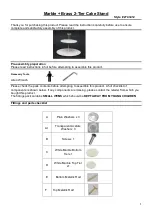
Q01-4000
Rev G Page 22 of 28 Teledyne Battery Products
COMPONENT MAINTENANCE MANUAL
Pre
mi
um
LT
V
alv
e R
eg
ula
te
d L
ea
d A
cid
Airc
ra
ft B
att
erie
s B
y TE
LED
YN
E
BA
TTE
RY
P
RO
D
UC
TS
11. GLOSSARY
Active material
The formed (charged) material on the positive and negative electrodes
(plates).
AGM
Absorptive Glass Mat, a non-woven fiberglass separator that holds the
electrolyte.
Ah
Ampere-hour; the standard designation of capacity units for batteries.
CFR
Code of Federal Regulations.
Electrolyte
The liquid added to a battery that is capable of conducting ions between
the two electrodes.
Electrolysis
Decomposition of an electrolyte by the action of an electric current
flowing through the electrodes (positive and negative plates).
IATA
International Air Transport Association.
ICAO
International Civil Aviation Organization.
IEC
International Electrotechnical Commission.
I
pp
Peak current delivered at 0.3 seconds into a 15 second controlled
discharge at a constant terminal voltage of half the nominal battery
voltage.
I
pr
Discharge current at the conclusion of a 15 second controlled discharge
at a constant terminal voltage of half the nominal battery voltage
Nonspillable
Refers to the ability of the battery to retain the electrolyte when subjected
to tests identified under US DOT Reg 49 CFR, Part 173.159, paragraph
“d”.
OCV
Open Circuit Voltage; measured with no loads connected to the battery.
Passivation
Refers to the oxidation of the negative electrode.
Recombination
The process by which oxygen combines (reacts) with the negative active
material.
Sponge lead
Fully charged negative plates convert to a very porous pure lead material,
often referred as sponge lead since it resembles a sponge under high
magnification.
Sulfation
The product of discharge, lead sulfate, formed on both positive and
negative plates.
Venting
Means for a battery to release the gases it generates during charging.
VRLA
Valve-Regulated Lead-Acid






































